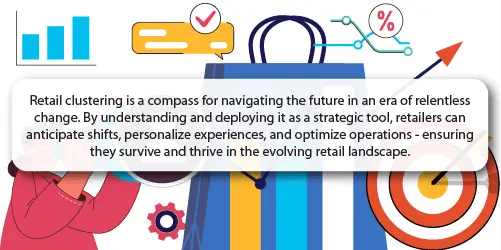Retail clustering is a pivotal strategy for businesses navigating the complexities of retail. It's simple to understand why when you consider what it involves. Meticulously segmenting stores to align with the demographics and behaviors of varied consumers enables retailers to craft tailored experiences and offerings. Such precision bolsters adaptability and resilience while ensuring retailers meet customer needs with unwavering accuracy and innovation.


Crafting an effective retail clustering strategy
Crafting an effective retail clustering strategy is foundational to achieving resilience and adaptability. This process involves a blend of data analysis, customer segmentation, and responsiveness to market trends, all aligned with the overarching goals of the retail business.
Understanding the customer base
The first step in developing a retail clustering strategy is understanding customers. Retailers can achieve this through thorough data analysis and customer segmentation.
Retail giants like Target and Walmart excel here by leveraging data analytics to dissect vast amounts of customer data, identifying patterns in purchasing behavior, preferences, and demographics. South African retailers like Food Lovers Market, Dis-Chem, and Makro do the same.
This granular understanding allows them to tailor store layouts, product assortments, and overall retail clustering strategy to meet the specific needs of different customer segments within their market areas.
Responding to market trends
Adaptability to market trends is another critical component.
Retailers like Best Buy and Home Depot, which swiftly pivoted to e-commerce and curbside pickup during the COVID-19 pandemic, are prime examples of this dynamism. Today, their innovation extends beyond pandemic responses to embrace sustainability and digital integration.
For example, many retailers now incorporate sustainable products and practices into their clusters, targeting environmentally conscious consumers. Additionally, retailers can use digital tools and apps to enhance the in-store experience, leveraging technology to meet evolving consumer expectations.
A mobile app can help deliver customized promotions and product recommendations to customers based on their purchase history and preferences and direct them to the stores with these items if they want to shop in person.
Aligning with business goals
Strategic alignment with business goals underpins any successful retail clustering strategy.
For example, a store might have a strategy that includes placing large stores in suburban areas as a way to align with its goal of providing a wide range of products at low prices. Each store might serve as a destination, attracting customers from a broad geographic area to travel for the shopping experience.
It is a clustering strategy that can support a retailer’s business model of volume sales and self-service, showcasing how store placement and format are critical components of retail strategy.
An effective retail clustering strategy requires a nuanced understanding of the customer, agility in response to market trends, and strategic alignment with business objectives. Retailers who master this approach can navigate the complexities of the retail landscape, ensuring long-term success and adaptability.

Personalizing the shopping experience with retail clustering
Personalizing the shopping experience through retail clustering is a strategic approach that significantly enhances customer loyalty, satisfaction, and sales. By recognizing and catering to the unique preferences of different customer segments within various geographical locations, retailers can create highly tailored shopping experiences.
Tailored product assortments
A key aspect of personalization is the customization of product assortments to match local tastes and preferences. Another way to describe it is localized assortment planning.
For example, grocery chains like Kroger use sophisticated data analytics to understand their top and worst-performing stores. In areas with a higher preference for organic products, Kroger may stock a broader range of organic options. In regions with a demand for ethnic foods, they might offer an expanded selection of those products.
This strategic alignment of product offerings with local preferences boosts customer satisfaction and drives sales by meeting specific customer needs more effectively. It also applies to other retailers - tailoring a product assortment and clustering stores based on customer preferences becomes a strategic step.
Localized marketing and promotions
Store and retail clustering enables retailers to implement localized marketing strategies and promotions, further personalizing the shopping experience.
A retailer could tailor its marketing efforts and promotional activities to customer preferences across different stores.
For example, a store in a metropolitan area might focus on luxury skincare and makeup brands, accompanied by targeted marketing campaigns for urban professionals. Meanwhile, a store in a suburban area might emphasize family-friendly beauty products and promotions.
Enhancing customer loyalty
The personalization facilitated by store clustering also significantly enhances customer loyalty.
Starbucks provides a prime case by adapting its store formats and product offerings to local markets. Starbucks might offer express stores focused on quick service and mobile ordering in busy city centers. In suburban areas, larger stores with more seating space cater to customers looking for a place to relax or meet friends.
This strategic approach to personalization ensures that customers find what they need when they need it, fostering a strong sense of brand loyalty.
Retail clustering is a viable strategy for personalizing the shopping experience, playing a crucial role in helping meet the unique needs of different customer segments, thereby enhancing satisfaction, loyalty, and sales. Retailers implementing this strategy are well-positioned to build lasting customer relationships.

Ensuring operational excellence through strategic retail clustering
Strategic retail clustering offers significant operational advantages, enhancing inventory optimization, supply chain efficiency, and overall cost savings. This approach reduces waste and fosters a more agile and responsive retail operation, which is critical for ongoing adaptation.
Enhanced inventory optimization
One of the primary benefits of retail clustering is the ability to optimize inventory according to the specific demands of different customer groups.
For example, a fashion retailer could use retail clustering to tailor its inventory to regional fashion trends and preferences, minimizing overstock and understock situations. By analyzing sales data, such a retailer can ensure that stores in each cluster receive the right mix of products, leading to higher turnover rates and reduced markdowns.
This precise approach to inventory management allows for a leaner operation, minimizing waste and maximizing sales potential.
Efficient supply chain management
Retail clustering also streamlines supply chain operations by enabling more efficient distribution and replenishment strategies.
Take, for example, a retailer that clusters its stores based on geographic location and demographic profiles. Doing so facilitates a more streamlined distribution process.
By understanding the specific needs of each cluster, such a retailer can optimize its logistics routes and warehouse stock, ensuring timely deliveries and reducing transportation costs. This efficiency lowers operational costs and improves the customer experience through better product availability.
Cost savings and responsiveness
Operational efficiencies gained from strategic retail clustering also lead to significant cost savings.
Consider a big box store that leverages retail clustering to customize its product assortments based on local market demands and seasonal trends. This customization reduces the risk of overstocking unpopular items, which lowers storage and markdown costs.
Additionally, such strategic clustering allows such a retailer to respond quickly to market changes, such as sudden increases in demand for specific products due to weather events or local projects, further enhancing operational agility.

Leveraging retail clustering for market adaptability
Leveraging retail clustering for market adaptability is a necessary strategic action given retail's current competitiveness. This approach empowers retailers to swiftly respond to market changes, consumer behavior shifts, and emerging trends, ensuring they stay ahead of the curve through flexibility and innovation.
Swift adaptation to market changes
Retail clustering enables businesses to adapt quickly to changing market dynamics by segmenting stores based on location, demographics, and consumer behavior.
For example, a clothing retailer could utilize retail clustering to modify its layouts and product offerings in response to regional athletic preferences and trends. In areas with a higher interest in running, stores might feature a broader selection of running shoes and gear. In regions where basketball is more popular, the focus shifts accordingly. This strategy allows a retailer to stay relevant and responsive to the evolving interests of its customers.
Consumer behavior insights for innovation
Understanding and reacting to shifts in consumer behavior is another advantage of retail clustering.
Starbucks, known for its customer-centric approach, ensures its stores cater to local tastes and preferences. Internationally, Starbucks adapts its menu and store design to align with local cultures and tastes, such as offering matcha-flavored drinks in Japan or incorporating region-specific architectural elements in in-store designs.
This sensitivity to consumer behavior helps Starbucks innovate continuously, ensuring high customer engagement and satisfaction.
Flexibility and innovation
The strategic flexibility inherent in retail clustering fosters innovation, allowing retailers to test new concepts and offerings in specific markets before broader rollouts.
A fast-fashion retailer could test new fashion lines or sustainability initiatives in select clusters to gauge customer response. This approach mitigates risks associated with new launches and injects innovation into the business model, keeping a brand dynamic and competitive.
Retail clustering is a pivotal strategy for retailers aiming to maintain market adaptability. By enabling swift adaptation to market changes, providing insights for innovation, and offering the flexibility to experiment safely, retail clustering positions businesses to navigate the complexities of the retail environment.
Conclusion
Retail clustering offers retailers a robust strategy to future-proof their operations. By embracing this approach, businesses can adapt proactively to market trends and consumer needs. Are you interested in implementing clustering in your business? Explore how with DotActiv Enterprise - start your journey today with a free 14-day trial.


